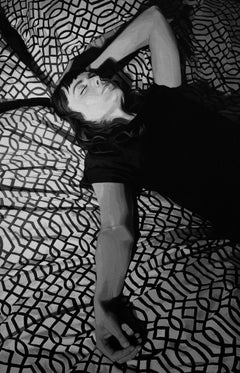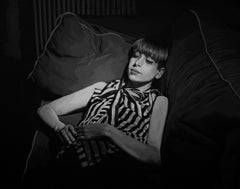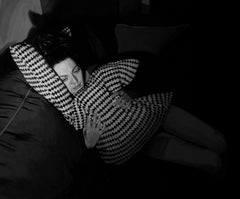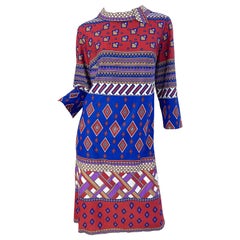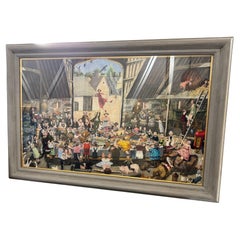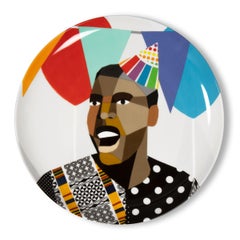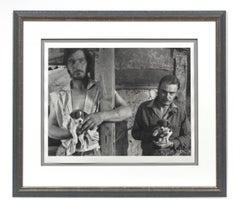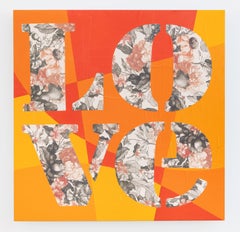B Adams
to
4
25
10
15
13
11
10
6
6
5
4
3
3
2
2
2
2
1
1
1
1
1
3
3
3
2
1
Sort By
"Jaime #1" (2016) By Rebecca Mason Adams, Original B&W Photorealist Painting
By Rebecca Mason Adams
Located in Denver, CO
"Jaime #1" By Rebecca Mason Adams is a beautiful original photorealist acrylic on canvas painting
Category
2010s Photorealist Portrait Paintings
Materials
Acrylic, Canvas
"Laura #1" (2016) By Rebecca Mason Adams, Original B&W Photorealist Painting
By Rebecca Mason Adams
Located in Denver, CO
"Laura #1" By Rebecca Mason Adams is a beautiful original photorealist acrylic on canvas painting
Category
2010s Photorealist Portrait Paintings
Materials
Canvas, Acrylic
"Michelle #2" (2016) By Rebecca Mason Adams, Original B&W Photorealist Painting
By Rebecca Mason Adams
Located in Denver, CO
"Michelle #2" By Rebecca Mason Adams is a beautiful original photorealist acrylic on canvas
Category
2010s Photorealist Portrait Paintings
Materials
Canvas, Acrylic
1960s Amy Adams for B. Altman Abstract Print 3/4 Sleeves Vintage 60s Knit Dress
By B. Altman & Co.
Located in San Diego, CA
Amazing 1960s AMY ADAMS for B. ALTMAN abstract print knit dress ! Features warm colors of brown
Category
1960s American Cocktail Dresses
HARVEST SUPPER by Richard Adams (b. 1960)
Located in Basildon, GB
Original varnished pastel by Richard Adams (born 1960).
'Harvest Supper' , and signed by artist
Category
Early 2000s British Paintings
Materials
Plywood
Derrick Adams, We Came to Party and Plan 38 - Limited Edition Plate
Located in Hamburg, DE
Derrick Adams (American, b. 1970)
We Came to Party and Plan 38, 2022
Medium: Porcelain plate (fine
Category
21st Century and Contemporary Pop Art Figurative Prints
Materials
Porcelain
$1,804
H 0.79 in Dm 10.52 in
Shelby Lee Adams, American B. 1950 'The Napier Brothers with Puppies' 1993 25/25
Located in West Palm Beach, FL
Shelby Lee Adams (American, b. 1950).
The Napier brothers with Puppies
Silver gelatin print, 25/25
Category
Late 20th Century American Modern Photography
Materials
Glass, Wood, Paper
$2,360 Sale Price
20% Off
H 25 in W 28 in D 1 in
Love (Orange)
By Cey Adams
Located in Fort Lauderdale, FL
Cey Adams (b. 1962)
Love (Orange), 2023
Mixed media collage on panel
24 x 24 x 3 in
Category
2010s Contemporary Mixed Media
Materials
Mixed Media
American Flag (1961)
By Cey Adams
Located in Fort Lauderdale, FL
Cey Adams (b. 1962)
American Flag (1961), 2024
Mixed media collage on panel
72 x 36 x 4 in
Category
2010s Contemporary Mixed Media
Materials
Mixed Media, Wood Panel
American Flag (Here Again)
By Cey Adams
Located in Fort Lauderdale, FL
Cey Adams (b. 1962)
American Flag (Here Again), 2024
Mixed media collage on panel
46 x 24 x 3 in
Category
2010s Contemporary Paintings
Materials
Mixed Media, Wood Panel
Free More, original Zabriskie Gallery & Reader's Digest Collection labels signed
By Pat Adams
Located in New York, NY
Pat Adams
Free More, 1989
Acrylic and encaustic painting with varnish on paper laid down on canvas
Category
1980s Abstract Abstract Paintings
Materials
Varnish, Encaustic, Acrylic, Mixed Media, Pencil, Graphite
$20,500
H 15.5 in W 17.7 in D 1 in
Extended Alike
By Pat Adams
Located in New York, NY
vintage frame
PAT ADAMS BIOGRAPHY:
Pat Adams Biography:
Pat Adams (American, b. 1928) was raised in
Category
1960s Abstract Abstract Paintings
Materials
Paper, Gouache
Peter Michael Adams, Mid-Century, Sculptural Coffee Table, Walnut, USA, 1970s
Located in Manhasset, NY
MICHAEL ADAMS (American, b. 1946)
Walnut
United States, 1970s
PIXA
Category
Late 20th Century Mid-Century Modern Coffee and Cocktail Tables
Materials
Wood
$28,500
H 21 in W 64 in D 33 in
Batman
Located in London, GB
art work on this poster is by Neal Adams (b. 1941)
This poster would be shipped rolled in a strong
Category
Vintage 1970s Japanese Posters
Materials
Paper
"Road to Provincetown, " Henry MacGinnis, Massachusetts Landscape
By Henry Ryan MacGinnis
Located in New York, NY
showed his work with other notable Hoosier artists such as T.C. Steele, J. Ottis Adams, R.B. Gruelle
Category
1920s American Impressionist Landscape Paintings
Materials
Canvas, Oil
B Cube
By Lisa Adams
Located in Old Lyme, CT
Lisa Adams embraces wit and humor illustrating the letter B on her Art Cube, handmade by New York
Category
21st Century and Contemporary Contemporary Sculptures
Materials
Acrylic Polymer, Wood
Compass Square Coffee Table by DANAD Design, circa 1960s
By Danad Design
Located in London, GB
Tom Adams (b. 1926) as part of the DANAD Design collective, (1958-1962).
The laminate surface art is
Category
21st Century and Contemporary English Coffee and Cocktail Tables
Materials
Steel
English or American Quillwork Wine Coaster Late 18th Early 19th Century
Located in Woodbridge, CT
the underside: ”This box was made by my mother’s great Aunt Rhoda Adams b.1790 and given to my Aunt
Category
Antique Early 19th Century English Adam Style Wine Coolers
Materials
Paper, Wood
Shady Lane, Abstract Cedar Basket, Polly Adams Sutton
Located in Wilton, CT
Shady Lane, Polly Adams Sutton, western red cedar bark, dyed ash, wire, cane, 16” x 12” x 9”, 2006
Category
Early 2000s Abstract Still-life Sculptures
Materials
Wire
$4,000
H 16 in W 12 in D 9 in
Antique Brass and Jasperware Desk Set James Howell, 19th Century
By James Howell
Located in London, GB
, produced to the designs of M. B. Adams by of Burmantofts.
In 1884 the company became a limited company
Category
Antique 1860s English Desk Sets
Materials
Brass
$1,633 / set
H 7.88 in W 7.88 in D 7.88 in
Pair of Cast Iron Horse Leg Form Building Fenders Attributed to William Adams
Located in Milford, NH
William Adams, a Philadelphia iron worker (b.1833). Adams, who after being in partnership under the name
Category
Antique Late 19th Century American Architectural Elements
Materials
Iron
$3,900 / set
H 24.5 in W 6 in D 9.5 in
Antique Ebonised and Brass Stationary Casket Howell James & Co. 19th Century
By Howell James & Co.
Located in London, GB
architectural faience, produced to the designs of M. B. Adams by of Burmantofts.
In 1884 the company became a
Category
Antique 1860s English Decorative Boxes
Materials
Brass
$590
H 6.3 in W 8.67 in D 4.73 in
Antique Brass and Jasperware Desk Set James Howell 19th Century
Located in London, GB
architectural faience, produced to the designs of M. B. Adams by of Burmantofts.
In 1884 the company became a
Category
Antique 1860s English Desk Sets
Antique Victorian Betjemann's Coromandel Book Slide, 19th Century
By Betjemanns & Sons
Located in London, GB
exhibition was staged, of architectural faience, produced to the designs of M. B. Adams by Burmantofts. In
Category
Antique 1860s English Victorian Bookends
Materials
Brass
$1,529
H 7.09 in W 27.17 in D 3.55 in
Antique English Staffordshire Transferware Serving Creamer Jug Pitcher
Located in Dayton, OH
printed earthenwares impressed ‘B. ADAMS’. The marked blue printed wares are of a light blue tone and none
Category
Early 20th Century Late Victorian Porcelain
Materials
Porcelain
$235
H 5.25 in W 6 in D 7.25 in
Antique Lady's Vanity Case Howell James & Co 1878
Located in London, GB
, of architectural faience, produced to the designs of M. B. Adams by of Burmantofts. In 1884 the
Category
Antique Late 19th Century English More Furniture and Collectibles
Beaumont-Adams Revolver with Gold Damascene Embellishment and Original Case
By Robert Adams 1
Located in Hamilton, Ontario
Designers:
Lt. Frederick E.B. Beaumont
Robert Adams
Year designed:
1856
Production began:
1856
Category
Antique 19th Century English Arms, Armor and Weapons
Materials
Metal
$25,000
H 2.5 in W 14.5 in D 7.5 in
19th Century Howell James & Company Postal Letter Scale
By Howell James & Co.
Located in Hamilton, Ontario
, produced to the designs of M. B. Adams by Burmantofts. In 1884 the company became a limited company and
Category
Antique 1880s English Victorian Scientific Instruments
Materials
Brass
Morning Merced River Canyon Yosemite - Special Edition
By Ansel Adams
Located in Soquel, CA
Silver gelatin photograph by Ansel Adams (American, 1902-1984), printed by Alan Ross (American, b
Category
1980s Photorealist Black and White Photography
Materials
Photographic Paper, Silver Gelatin
$1,000
H 14.13 in W 17 in D 1.5 in
Antique Victorian Coromandel Games Compendium Chess Drafts Etc 19th Century
Located in London, GB
galleries. An exhibition was staged, of architectural faience, produced to the designs of M. B. Adams by of
Category
Antique 1860s English Games
Materials
Malachite, Brass
$2,432
H 6.3 in W 12.6 in D 9.45 in
"Baker Pond, New Hampshire, " Henry MacGinnis, New England Landscape
Located in New York, NY
Adams, R.B. Gruelle, William Forsyth, Otto Stark and Clarence Ball.
In 1900, MacGinnis left Indiana to
Category
1930s American Impressionist Landscape Paintings
Materials
Canvas, Oil
$9,000
H 35.5 in W 30.5 in
Party Guest, 2020 Screen print, relief, fabric collage 24x18 in. Edition of 50
Located in Atlanta, GA
Derrick Adams (b. 1970) is a multidisciplinary artist based in Brooklyn, New York. He received his
Category
2010s Abstract Figurative Prints
Materials
Screen
Boy on Swan Float, 2020 Woodblock, screen print, fabric, collage Edition of 30
Located in Atlanta, GA
Derrick Adams (b. 1970) is a multidisciplinary artist based in Brooklyn, New York. He received his
Category
2010s Abstract Figurative Prints
Materials
Screen
Self Portrait on Float
Located in Atlanta, GA
2019, Woodblock, gold leaf, collage, Edition of 50, 40 x 40 inches
Derrick Adams (b. 1970) is a
Category
2010s Abstract Figurative Prints
Materials
Screen
Party Guest
Located in Atlanta, GA
2020, Screen print, relief, fabric collage, Edition of 50, 24 x 18 inches
Derrick Adams (b. 1970
Category
2010s Abstract Figurative Prints
Materials
Screen
Bronze abstract sculpture
Located in Washington, DC
Powerful bronze table sculpture on a blackened bronze base by Ilyana Y. Adams (American,b. 1924
Category
Vintage 1980s American Mid-Century Modern Sculptures
Materials
Bronze
19th Century Howell James Gilt Bronze Jeweled Strut Clock, Leather Case
Located in Melbourne, Victoria
M. B. Adams by Burmantofts. In 1884 the company became a limited company and their name changed to
Category
Antique Mid-19th Century English Table Clocks and Desk Clocks
Materials
Bronze
$1,525
H 5.5 in W 5.5 in D 1.5 in
Thomas Sargent Palissy Ware Majolica Wall Clock circa 1870 Japy Freres Movement
By Japy Frères, Howell James & Co., Thomas Sargent
Located in Melbourne, Victoria
galleries. An exhibition was staged, of architectural faience, produced to the designs of M. B. Adams by
Category
Antique 1870s Wall Clocks
Materials
Majolica
$2,395
H 17 in W 12.5 in D 5 in
The Signing of the Declaration of Independence, July 4.1776
By John Trumbull
Located in New York, NY
-invigorate the courage of the colonists, B. Franklin, J. Adams and a number of other Representatives put
Category
Early 19th Century Realist Figurative Prints
Materials
Engraving, Paper
$2,700
H 31 in W 39.5 in
Get Updated with New Arrivals
Save "B Adams", and we’ll notify you when there are new listings in this category.
B Adams For Sale on 1stDibs
An assortment of b adams is available on 1stDibs. Finding the ideal contemporary, Impressionist or Surrealist examples of these works for your living room, whether you’re looking for small- or large-size pieces, is no easy task — start by shopping our selection today. There are many variations of these items available, from those made as long ago as the 19th Century to those made as recently as the 21st Century. B adams available on 1stDibs span a range of colors that includes gray, black, brown, blue and more. Harold Davis, Harry Adams, Bruce Adams, Benjamin Duke and John Hrehov took a thoughtful approach to this subject that are worth considering. The range of these distinct pieces — often created in paper, paint and photographic paper — can elevate any room of your home.
How Much are B Adams?
Prices for art of this kind can differ depending upon size, time period and other attributes — b adams in our inventory begin at $60 and can go as high as $190,000, while the average can fetch as much as $1,725.
More Ways To Browse
Sculptural Coffee Tables
Large Buffet Sideboard
Green Buffet
Brass Demilune
Hand Painted Tall Cabinet
Antique Spanish Candle Holders
Antique Tall Sideboard
Antique Demilune Cabinet
Antique Silver Candle Sconce
Spain Urns
Sterling Silver Column Candlesticks
Antique Spanish Candlestick
1920s Dining Room Buffet
Painted Demilune Cabinet
Houdon Bronze
Putti Clodion
Terracotta Putti
Paper Cut Silhouettes
